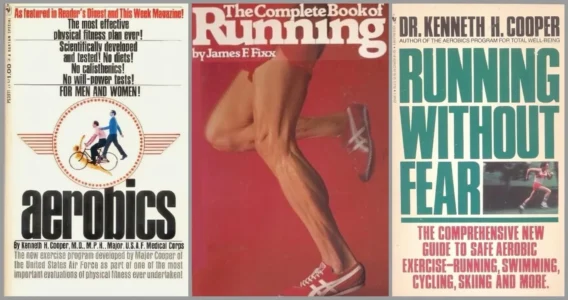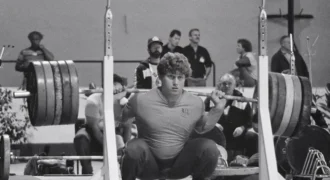Cover Image Photo by Joseph McCray, LiftingLife.com
Introduction
The truth about Charles R. Poliquin’s revolutionary fat-loss workout
In the 1970s and 1980s, the prevailing belief among the medical community and mainstream media was that weight training builds muscle and aerobic training burns fat. Want to build your biceps? Grab a barbell and pump iron like Arnold. Want to get rid of that dad bod and avoid a heart attack? Lace up your sneakers and spend 30 minutes on a treadmill in your aerobic zone. Not quite.
We now know that all the health benefits of aerobic training can also be achieved through weight training, and we also know that aerobic training may negatively affect athletic performance. Regarding getting and staying lean, for four decades, Charles R. Poliquin championed the cause of weight training for weight loss with his German Body Comp (GBC) program.
Before exploring the reps and sets of this legendary strength coach’s innovative training method, let’s take a closer look at the benefits of aerobic training.
The Aerobic Delusion
The best advice I was given when I started writing for the fitness industry was “In this business, when it comes to a battle between emotion and logic, emotion always wins.” Case in point: Richard Simmons.
When Congress called a special session in 2008 to address childhood obesity, they invited Simmons to Capitol Hill. Simmons has a degree in fine arts and claimed he had never played a sport or taken part in PE. Still, it’s undeniable that this skinny guy with his flamboyant outfits inspired millions to lose weight by “Sweatin’ to the Oldies.” Many other fitness celebrities promoted the Church of Cardio, including Dr. Kenneth Cooper.
Cooper earned the nickname “The Father of Aerobics,” and his books sold over 30 million copies. When I was in the Air Force in the late 70s, one of my jobs was to help monitor the mile-and-a-half running test that he had developed for the military. The standards were that males had to finish the course in 15:50 or less (I did it in nine minutes flat—thank you very much) and women in 18:56 or less. Because many servicemen at my base didn’t run, I would always have a walkie-talkie ready to call an ambulance if one of them passed out or pulled a hamstring.
While almost any type of exercise is better than no exercise, many fitness celebrities have misunderstood, or rather overestimated, the value of aerobic training. Consider the example of running guru James E. Fixx, the author of the bestseller The Complete Book of Running, who died at 52 during his daily run. Despite being capable of running marathons, an autopsy revealed he had severe blockage in his coronary arteries. How is this possible?
According to cardiologist Henry A. Solomon, MD, in his book The Exercise Myth, “Cardiovascular health refers to the absence of disease of the heart and blood vessels, not to the ability of an individual to do a certain amount of physical work.” It could be said that Cooper endorsed this opinion in his book Running Without Fear, which he wrote in response to Fixx’s death.
In his book, Cooper listed his top 10 risk factors for cardiovascular disease. The first was family history and heredity, and the seventh—not the second—was inactivity and sedentary living habits. During my interview with Cooper (I was a writer for Runner’s World Publications at the time), he said that if you run for more than 30 minutes three times a week, you’re doing it for something other than fitness.
If you run for more than 30 minutes three times a week, you’re doing it for something other than fitness, says Dr. Kenneth Cooper in an interview with Kim Goss
Share on X
Now, let’s look at how well aerobic training works for losing body fat.

Image 1: Dr. Kenneth “The Father of Aerobics” Cooper’s books sold over 30 million copies. Running guru James E. Fixx helped popularize running for health, but died at 52 during his daily run.
Aerobics and Fat Loss
In looking for the best ways to get slim and trim, consider the results of a 12-week study on the effects of aerobic exercise on obese women published in the International Journal of Sports Nutrition in 1998.
On average, these subjects lost only 2.9 pounds (1.3 kilograms). Again, after three months. Such underwhelming results led author Alan Utterto to conclude the following: “Results indicate that moderate aerobic exercise training during a 12-week period has no discernible effects on body composition but does improve cardiorespiratory fitness in dieting obese women.”
From a meta-analysis perspective, a review of 42 studies involving 3476 subjects revealed that small weight losses were reported, but that more intense exercise “increased the magnitude of weight loss.” Furthermore, a 1994 study published in Metabolism found that higher workout intensities were more effective in reducing (listen up, pre-contest bodybuilders!) subcutaneous fat, which is the layer of fat just below the skin.
Some fat loss is better than no fat loss, but let’s also consider the downsides of aerobic training.
When Poliquin introduced me to his GBC program in the early 1990s, he said that one of the issues with aerobic classes was that overweight people often avoided them because they were embarrassed by their appearance. Wearing baggy, oversized sweatsuits to conceal their body shape doesn’t help the cause. These individuals may brave a class or two, staying in the back row, but will often struggle to keep up with the easiest movements and quit in frustration. For these reasons, Poliquin believed that aerobic classes weren’t necessarily helping people get lean, but rather that those who attended these classes were already fit.
Another issue with overweight individuals trying to participate in many types of aerobic activities is that they often come in with orthopedic problems. Patellar tendinitis and sciatica don’t mix well with step aerobics classes. For this reason, Poliquin recommends that these individuals should “get in shape” with resistance training (and possibly some corrective exercises) before attempting certain aerobic activities, such as step classes. (By the way, Poliquin also said that overweight individuals are often stronger than slender non-lifters, especially in the legs, because of the extra weight they carry. As a result, they get a motivational boost from resistance training workouts because they can often lift significant amounts of weight, particularly with lower-body exercises.)
Poliquin recommends that these individuals should “get in shape” with resistance training (and possibly some corrective exercises) before attempting certain aerobic activities, says Kim Goss
Share on X
Finally, performing too much aerobic exercise can lead to some individuals gaining body fat. Seriously. “Aerobic training places excessive stress on the adrenal glands and negatively affects the testosterone/cortisol hormone ratio, factors which reduce the ability to gain muscle and increase the likelihood of gaining fat,” says Posturologist and strength coach Paul Gagné. “In fact, studies show that female aerobics instructors who taught an average of three hours a day had about 24 percent body fat.” Poliquin called this effect the “Chunky Aerobics Instructor Syndrome.”
With that background, let’s examine why weight training may be the best option for fat loss.

Image 2: Strength Coach Charles Poliquin working with gymnast and weightlifter Jessi Butterfield. (Blair Kunz photo on right courtesy BFS magazine)
The Growth Hormone Edge for Fat Loss
I met weightlifter and sports scientist Mike Stone, PhD, while I was in the Air Force during the late 1970s. I was fascinated by his research on the health benefits of weight training, especially weightlifting. One of his papers, which I consider a classic, was “Cardiovascular Responses to Short-Term Olympic Style Weight-Training in Young Men,” published in the Canadian Journal of Applied Sport Sciences in 1983.
After two months of following conventional weightlifting training protocols, Stone’s lifters decreased their bodyfat by six percent and increased their lean mass by four percent. These subjects also experience positive changes in many health markers, including a decrease in heart rate and resting systolic blood pressure. There was also the benefit of increased growth hormone production, a biochemical associated with fat loss.
In a 2012 paper on weightlifters published in Sports Medicine, the authors reported a 4.5-13-fold increase in growth hormone in weightlifters “in response to their high-intensity, high-power training.” This begs the question, “What is the optimal training intensity for growth hormone production?” One sports scientist with an answer was William Kraemer, PhD, a sports scientist whom Poliquin frequently cited.

Image 3: The high-intensity workouts of weightlifters stimulate the production of growth hormone. Shown is 1976 Olympic Champion David Rigert, who broke 65 world records and clean and jerked 507 pounds. (Bruce Klemens photos)
Kraemer stated that the optimal rate of growth hormone production appears to be around 70-85 percent of an individual’s one-repetition maximum (1RM) in an exercise. (Thus, if you can bench press 100 pounds for one rep, you should aim to use approximately 70-85 pounds if your primary goal is to lose body fat.)
Based on my study of various research papers and textbooks by European weightlifting coaches, I observed that their workout routines frequently excluded lifts under 70 percent of their maximum weight. I assume these weights are considered warm-ups and are not performed at an intensity that would produce a beneficial training effect for the sport. Next, there’s the issue of rest intervals.
Poliquin told me that his GBC program is initially based on the research of Hala Rambie, a Romanian exercise scientist who defected to West Germany (hence the name German in GBC). Rambie found that, compared to the aerobic pathway, the lactic acid pathway is more effective for losing body fat. More specifically, he stated that short rest intervals create high blood lactic acid levels, which in turn lower blood pH levels and stimulate the production of growth hormone.
Short rest intervals are also valuable for athletes who require muscular endurance. Poliquin told me that police academies in Canada were prime candidates for GBC, as the training helped cadets pass the V02 max and muscular endurance tests. Poliquin added that he also had success using GBC with speed skaters and hockey players.
While the German Volume Training (GVT) program used rest intervals of 60-90 seconds to boost testosterone production for muscle gain, Poliquin’s original GBC program used shorter rest periods for fat loss.
Although GBC isn’t as effective as GVT for building muscle, its intensity was high enough to at least maintain it. GBC training sharply contrasts with traditional bodybuilders who would “bulk up” in the off-season, gaining a considerable amount of fat along the way, then “cut down” with extreme dieting and cardio to make their muscles “pop.” The downside of this “bulk up/cut down” approach was that it often resulted in a substantial loss of muscle mass.

Image 4: Professional football player Ethan Brooks hired Coach Poliquin to help him get in shape for the upcoming season. In just six weeks, Brooks reduced his body fat from 15.35 percent to 8.69 percent while gaining muscle.
Putting GBC to the Test
When I first learned about GBC from Poliquin, I decided to try it out on some of my athletes. The first was Karen Carpenter, a 5’3” ice dancer. She had retired from the sport when I met her, and her weight crept up to 149 pounds. Since figure skating is considered an aesthetic sport, when Carpenter decided to make a comeback, she needed to lose fat without gaining too much muscle.
Poliquin had worked with two elite Canadian figure skaters, Josée Chouinard and Elizabeth Manley, and thus understood the issues in that sport related to building muscle. Carpenter worked on her diet and started swimming, but when her progress stalled, I asked her to try GBC. The program enabled her to quickly reach a bodyweight of 106 pounds. So, N=1. However, for four years, I ran a figure skating strength and conditioning program in Plano, Texas, and often used the workout with these athletes.
Although Poliquin had discussed this workout in presentations in the 1980s, Laura Dayton introduced it to the general population in 1994 in a fitness magazine called Crosstrainer. The article was titled “The German Body Shaping System: Gaining Strength Without Size.” The following year, I read an editorial in that magazine that said this article was one of their most popular features in the history of their publication. (Oh, perhaps because the title German Body Shaping seemed to target only females and the book Manly Weight Loss didn’t sell well, Poliquin told me to start calling the workout German Body Comp.)

Image 5: The German Body Comp program was initially called the German Body Shaping System. It was featured in the December 1994 issue of Crosstrainer magazine. At right is figure skater Karen Carpenter, who used it to help her drop 43 pounds in her comeback to competitive figure skating. (Carpenter photo courtesy Karen Carpenter)
In terms of program design, GBC involves the following guidelines for these six major loading parameters:
1. Exercise Section
Focus on multijoint movements that involve a large amount of muscle mass, such as squats and bench presses.
2. Reps
Use a relatively higher number of reps, such as 8-12 (or even 15 for exercises with a shorter range of motion).
3. Sets
Use a relatively low number of sets, such as 3 or 4. Poliquin stressed that there is an inverse relationship between sets and reps—the more reps you perform, the fewer sets needed to see a training effect. Although I’ve seen GBC workouts designed by Poliquin where he prescribed five sets of an exercise, those were the exception, and often those sets were only performed for 1-2 exercises.
4. Intensity
The overload is primarily achieved through volume, not intensity. As a general guideline, if the workout recommends 8 to 10 reps, choose a weight that allows you to perform 12 reps to ensure you can complete all the reps.
5. Rest Intervals
Focus on relatively short rest intervals (about 30 seconds) to stimulate the highest levels of growth hormone production and improve muscle endurance. That said, I saw GBC workouts that Poliquin designed where he would allow up to 60 seconds of rest for challenging exercises that recruited a large amount of muscle mass, such as back squats. However, the other exercises in these workouts would usually focus on 30-second rest periods.
6. Frequency
Except for beginners, Poliquin preferred to keep most of his training phases to about 2-3 weeks. If nothing else, this approach helps with motivation because fast-paced GBC workouts can become very monotonous quickly.
When you start using GBC workouts, consider including a break-in period because short rest intervals can initially cause nausea—trust me on this! Using a superset protocol, here is how two exercises could be organized in a four-week GBC beginner program:

Image: Sample GBC Program Using a Dumbbell Split Squat Superset with a Dumbbell Row
After this introductory phase, workout cycles can start with 45 to 30 seconds of rest between sets. However, when beginning a new training phase with different exercises, especially for the first workout, allow yourself a little more rest time between sets to avoid nausea. For detailed examples of GBC workouts, pick up a copy of Poliquin’s German Body Comp Program, published in 2006 (and, if you can find it, his book Manly Weight Loss, published in 1998).

Image 6: Detailed GBC workouts can be found in Charles R. Poliquin’s book German Body Comp Program, published in 2006, and Manly Weight Loss, published in 1998.
At this point, a strength coach or personal trainer can get creative.
Let’s say a strength coach is working with a football lineman who is a bit too “chunky” to last four quarters. They could have this athlete alternate between two-week training phases: an accumulation phase (high volume) and an intensification phase (high intensity). In this example, GBC would be considered a high-volume workout, and training systems such as 5×5 (popularized by Bill Starr and Mark Rippetoe) could be classified as a high-intensity workout. Such a workout system would enable these athletes to become stronger and lower their body fat (thus increasing their endurance) without traumatizing their joints through steady-state aerobic work.
On a larger scale, consider that America’s obesity rates continue to rise across all levels. A 2021 government survey estimated that 16.3 percent of high school students are obese, and another 16 percent are overweight. Based on current public health trends (and from what I’ve observed at my high school reunions), the body composition of young men and women is likely to worsen significantly in adulthood. A GBC class could help these students get fit and achieve a healthy bodyweight.
Additionally, consider that approximately 70 percent of children stop participating in organized sports by age 13. GBC classes may help some students who were cut from their favorite sport make the team next season.
If you like doing aerobics, keep doing aerobics—jog, disco dance, walk your dog…whatever. If your goal is athletic superiority and body composition is an issue, consider Charles R. Poliquin’s German Body Comp program.
References
Solomon, Henry A. The Exercise Myth, Sep 2, 1984, Harcourt.
Cooper, Kenneth H. Running Without Fear. January 1, 1985, M. Evans and Company.
Utter, A. C., Nieman, D. C., Shannonhouse, E. M., Butterworth, D. E., & Nieman, C. N. (1998). Influence of Diet and/or Exercise on Body Composition and Cardiorespiratory Fitness in Obese Women. International Journal of Sport Nutrition, 8(3), pp. 213-222.
Shaw KA, Gennat HC, O’Rourke P, Del Mar C. Exercise for overweight or obesity. Cochrane Database of Systematic Reviews 2006, Issue 4.
Tremblay A, Simoneau JA, Bouchard C. Impact of exercise intensity on body fatness and skeletal muscle metabolism. Metabolism. 1994 Jul;43(7):814-8.
Gagné, Paul. Personal Communication, March. 2007.
Stone MH, Wilson GD, Blessing D, Rozenek R. Cardiovascular responses to short-term Olympic style weight-training in young men. Can J Appl Sport Sci. 1983 Sep;8(3), pp.134-9.
Storey A, Smith HK. Unique aspects of competitive weightlifting: performance, training and physiology. Sports Med. 2012 Sep 1;42(9):769-90.
Zatsiorsky, Vladimir M, and Kraemer, William J. Science and Practice of Strength Training, Second Edition, 2006, Human Kinetics, pp. 57-59.
Dayton, Laura and Goss, Kim. “The German Body Shaping System: Gaining Strength without Size. Crosstrainer, December 1994, pp. 83-87, 108.
Poliquin, Charles, Manly Weight Loss, 1998, Dayton Publications and Writer’s Group.
Poliquin, Charles. German Body Comp Program, 2006, Poliquin Performance Center, RI.
Centers for Disease Control and Prevention. 2021 Youth Risk Behavior Surveillance System, https://stateofchildhoodobesity.org/demographic-data/high-school/
The post Facts and Fallacies about German Body Comp Training appeared first on SimpliFaster.







